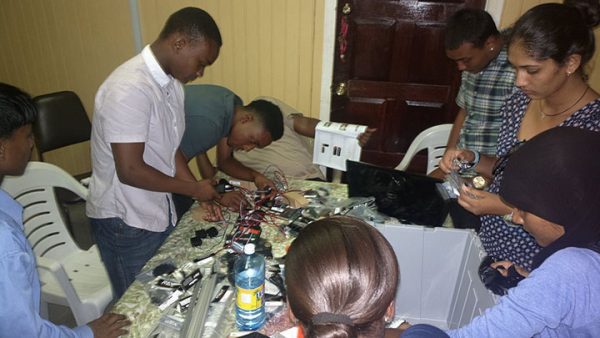STEMGuyana Co-Founder, Karen Abrams, talks with Guyana Review about the origins, challenges and objectives of the programme
GR: It has been three years since your family team brought the STEM technology programme to Guyana. Where do you hope to take the programme?
KA: We want to work with partners in Guyana to expose and engage as many young people as possible to the ‘backside’ of technology. Our young people have ‘a thing’ for gadgets. They’re familiar with the Internet, Instagram, facebook and so on… like citizens the world over, we’ve mastered consumption of IT.
Our goal is to have our young people understand and master the creation of IT. This is the space where the well – paid opportunities will be in the future both locally and globally.

GR: A fair measure of publicity has been given to the First Lady’s partnership with STEMGuyana. Tell us about that partnership.
KA: The First Lady has been a practical asset to our programme,. She has been a supporter, a friend and an advisor. She is not a detached Cheerleader. She understands what we’re trying to do. One only needs to look at her success with her own ICT program. She has helped with fundraising and with strategic advice with regard to where we need to be going. STEMGuyana has also partnered with the Office Of The First Lady to add a Robotics and Scratch coding component to her national ICT programme. The partnership works really well because our trainers get to spread the word nationally while they work to leave in place STEM clubs where young people can continue to develop their robotics and coding skills and even to compete in the national robotics competition to earn the right to represent Guyana in world competitions.
GR: STEMGuyana is still a relatively new phenomenon in Guyana. Tell us about the level of interest that it has generated
KA: Before our intervention in 2016, a programme for robotics and coding targeting young people did not exist in Guyana. Today, we have international agencies interested in rolling out programmes for us. Government is interested in rolling out programmes as is the private sector. STEMGuyana has helped to create an industry which will serve our country and more specifically our young people well in the future.
GR: Could tell our readers about the range of services offered.
KA: First we are the prequalifying body for three international Robotics competitions. We prepared teams for the First Global Robotics Competition in 2017 and 2018.
In 2019, we will join the World Robotics Organization [WRO] and the International Youth Robotics Competition [IYRC]. We will be having our local competitions to prequalify to represent Guyana in the primary, secondary and open youth categories. Young people all across the nation will be able to join our local League and participate in national competitions to represent Guyana.
Secondly, we want to ensure that what our students learn will be shared with other young people across the country. We have therefore created an outreach team of members who we train and certify to travel across Guyana to expose young people to Robotics and to leave STEM clubs in place.
Thirdly, we have launched Guyana’s first Coding Boot-camp programme where we provide access to software development courses. Coding Bootcamps serve to expedite training to create junior software engineers. We are hoping to prepare our young people for IT-related employment.
The courses are online and self-paced but members work at our facility in groups of three or four to complete the programme. Studies show that taking online courses in small groups increase the likelihood of completion and success. Upon completion, the young graduates will be able to develop apps and create websites, they will be able to work for local or global companies or simply work as freelancers to earn a pretty substantial wage.
We have also signed an agreement with Cisco NetAcademy to offer training in networking, security, and other areas of internet technology. This programme will be formally launched in December.
We are also focused on creating technology in spaces largely ignored but where the introduction of a technology product could bring significant relief to citizens or solve a lingering problem. To that end, we have worked with the Ministry of Education to create the NGSA mobile app, which enables students to practice old exams and provides reports for teachers on areas of weakness of students in their classrooms. We have three additional social good apps in the pipeline and will announce them later.
GR: How is STEMGuyana doing in terms of funding?
KA: Funding is always a challenge. It has been a question of donors becoming believers in what we are trying to do. After three years we still remain underfunded. Both the Office Of The First Lady and some state agencies have helped with funding for various components of our programme. Some of it is ‘on faith’ and upfront, by my family. We have received support from the diaspora, and sponsorships for t-shirts from the local private sector. As of today GTT has provided significant funding. We are thankful for the CEO’s vision. He understands how technology will shape our future.
We need a larger facility for training and office space. We need funds for robot kits, to pay our support staff, to properly market our programmes and to host training sessions. Some parents are willing to pay for our services but we don’t want to create a programme where the children of wealthy parents will gain exclusive access.
GR: Final question, what does success look like to you? What criteria will you use to judge STEMGuyana’s success?
KA: STEMGuyana will be a success when we are able to work with public and private partners to rollout out more than one hundred STEM clubs across Guyana targeted to both in-school and out-of-school students; exposing them to robotics, mathematics and coding, empowering them to learn new skills, to earn income by creating apps and websites and to create their own technology startups, right from their own villages and towns across Guyana.
I will judge STEMGuyana to be a success when we are able to attract and generate enough funds for an office, to pay staff, to market our program and to not only survive but thrive well into the future.
I will judge STEMGuyana to be a success when young people everywhere, in spite of their family income, ethnicity, party affiliation, sexual orientation or disability, have access to our services, take advantage of the opportunities offered and work together to build a future Guyana of which we can all be proud.








